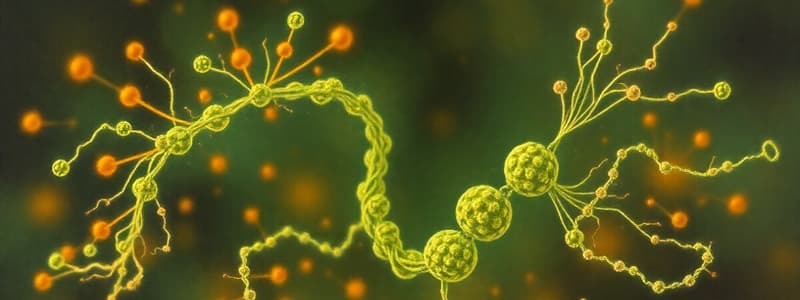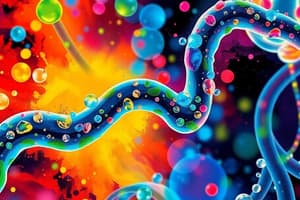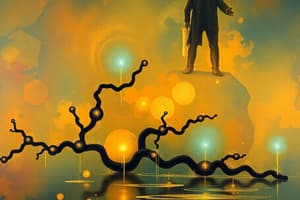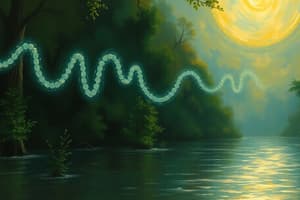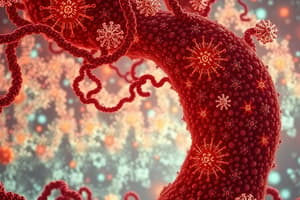Podcast
Questions and Answers
What is the primary role of NADH and FADH2 in ATP synthesis?
What is the primary role of NADH and FADH2 in ATP synthesis?
- They directly convert glucose into ATP.
- They pump protons which drive ATP synthesis. (correct)
- They act as regulators of glycolysis.
- They store energy in the form of glucose.
How many protons are pumped by one mole of NADH during oxidative phosphorylation?
How many protons are pumped by one mole of NADH during oxidative phosphorylation?
- 1 proton
- 4 protons
- 2 protons
- 3 protons (correct)
Which of the following processes generates NADH in the mitochondria?
Which of the following processes generates NADH in the mitochondria?
- Glycerol 3-phosphate Shuttle
- Malate Aspartate Shuttle (correct)
- Pentose Phosphate Pathway
- Glycolysis
What is the total theoretical yield of ATP from one mole of glucose in oxidative conditions?
What is the total theoretical yield of ATP from one mole of glucose in oxidative conditions?
Which statement about glycogen is accurate?
Which statement about glycogen is accurate?
Which enzyme is involved in the conversion of pyruvate to Acetyl-CoA?
Which enzyme is involved in the conversion of pyruvate to Acetyl-CoA?
What is the end product of glycolysis?
What is the end product of glycolysis?
Through which pathway is ribose 5-phosphate produced?
Through which pathway is ribose 5-phosphate produced?
Which enzyme is primarily regulated in gluconeogenesis?
Which enzyme is primarily regulated in gluconeogenesis?
What type of sugar is glycogen primarily composed of?
What type of sugar is glycogen primarily composed of?
What is the role of glycogenin in glycogen structure?
What is the role of glycogenin in glycogen structure?
Which statement correctly describes the glycogen synthesis process?
Which statement correctly describes the glycogen synthesis process?
How does glycogen function in skeletal muscle compared to the liver?
How does glycogen function in skeletal muscle compared to the liver?
What main products are produced during the oxidative reactions of the Pentose Phosphate Pathway?
What main products are produced during the oxidative reactions of the Pentose Phosphate Pathway?
Which of the following correctly describes a non-oxidative reaction in the Pentose Phosphate Pathway?
Which of the following correctly describes a non-oxidative reaction in the Pentose Phosphate Pathway?
How does glycogen degradation yield free glucose?
How does glycogen degradation yield free glucose?
In what form does glucose enter the glycolytic pathway after glycogen breakdown?
In what form does glucose enter the glycolytic pathway after glycogen breakdown?
What does a negative ΔG indicate about a metabolic process?
What does a negative ΔG indicate about a metabolic process?
Which process primarily accounts for substrate-level phosphorylation during glycolysis?
Which process primarily accounts for substrate-level phosphorylation during glycolysis?
What is the main role of the TCA cycle?
What is the main role of the TCA cycle?
Which of the following statements about gluconeogenesis is true?
Which of the following statements about gluconeogenesis is true?
How does the electron transport chain (ETC) interact with oxygen?
How does the electron transport chain (ETC) interact with oxygen?
Which of the following correctly describes glycogenolysis?
Which of the following correctly describes glycogenolysis?
What happens during the 'investment phase' of glycolysis?
What happens during the 'investment phase' of glycolysis?
What type of molecules are NADH and FADH2 in the context of ATP production?
What type of molecules are NADH and FADH2 in the context of ATP production?
What is the primary function of the pentose phosphate pathway?
What is the primary function of the pentose phosphate pathway?
Which of the following statements about ATP is correct?
Which of the following statements about ATP is correct?
Which of the following is NOT a characteristic of exergonic reactions?
Which of the following is NOT a characteristic of exergonic reactions?
What is the role of lactate in glycolysis under anaerobic conditions?
What is the role of lactate in glycolysis under anaerobic conditions?
What are the three rate-limiting steps in glycolysis associated with?
What are the three rate-limiting steps in glycolysis associated with?
Which compound is the direct substrate for the TCA cycle?
Which compound is the direct substrate for the TCA cycle?
Flashcards
Glycogen
Glycogen
A branched-chain homopolysaccharide composed of α-D-glucose units. It's a major carbohydrate storage form in animals.
Glycogen's linear chain
Glycogen's linear chain
In glycogen, glucose monomers are linked by α-(1,4) glycosidic bonds, forming linear chains.
Glycogen's branch
Glycogen's branch
In glycogen, branching occurs when glucose monomers are linked by α-(1,6) glycosidic bonds.
Glycogenin
Glycogenin
Signup and view all the flashcards
Glycogen in skeletal muscle
Glycogen in skeletal muscle
Signup and view all the flashcards
Glycogen in liver
Glycogen in liver
Signup and view all the flashcards
Glycogen synthesis
Glycogen synthesis
Signup and view all the flashcards
Glycolysis
Glycolysis
Signup and view all the flashcards
Glycogen degradation
Glycogen degradation
Signup and view all the flashcards
ATP (Adenosine Triphosphate)
ATP (Adenosine Triphosphate)
Signup and view all the flashcards
Electron Transport Chain (ETC)
Electron Transport Chain (ETC)
Signup and view all the flashcards
NADH
NADH
Signup and view all the flashcards
Gluconeogenesis
Gluconeogenesis
Signup and view all the flashcards
Glycerol 3-Phosphate Shuttle
Glycerol 3-Phosphate Shuttle
Signup and view all the flashcards
Malate-Aspartate Shuttle
Malate-Aspartate Shuttle
Signup and view all the flashcards
Pentose Phosphate Pathway
Pentose Phosphate Pathway
Signup and view all the flashcards
Bioenergetics
Bioenergetics
Signup and view all the flashcards
Bioenergetics
Bioenergetics
Signup and view all the flashcards
Free Energy Change (ΔG)
Free Energy Change (ΔG)
Signup and view all the flashcards
Exergonic Reaction
Exergonic Reaction
Signup and view all the flashcards
Endergonic Reaction
Endergonic Reaction
Signup and view all the flashcards
Substrate-level phosphorylation
Substrate-level phosphorylation
Signup and view all the flashcards
Oxidative phosphorylation
Oxidative phosphorylation
Signup and view all the flashcards
Glycogenolysis
Glycogenolysis
Signup and view all the flashcards
Glycogenesis
Glycogenesis
Signup and view all the flashcards
Citric Acid Cycle (TCA Cycle)
Citric Acid Cycle (TCA Cycle)
Signup and view all the flashcards
Oxidative Phosphorylation
Oxidative Phosphorylation
Signup and view all the flashcards
Study Notes
Bioenergetics
- Bioenergetics is the transfer and utilization of energy in biological systems.
- Bioenergetics predicts if a process is possible, while kinetics measures the reaction rate.
- Enzymes cannot make a reaction happen by themselves. They speed up reactions by lowering activation energy.
Bioenergetics (cont'd)
- Change in free energy (ΔG) is a measure of spontaneity.
- ΔG < 0 (negative): The reaction is spontaneous (exergonic).
- ΔG > 0 (positive): The reaction requires energy input (endergonic).
- ΔG = 0: The reaction is at equilibrium.
- Enzymes do not change ΔG but help reactions happen under conditions which otherwise would not occur.
ATP Production
-
Substrate-level phosphorylation is a metabolic reaction that results in the production of ATP.
-
During an enzymatic reaction, a phosphate group is transferred to ADP creating ATP.
-
Oxidative phosphorylation is a process that produces a large amount of ATP.
-
Electrons from NADH and FADH2 travel through the ETC and the energy from this process is used to pump H+ ions across the membrane to make ATP.
Carbohydrate Metabolism
- Carbohydrates are used to store energy in the form of glycogen (animals) and starch (plants).
- Glycolysis breaks down glucose to pyruvate producing ATP and NADH.
- Gluconeogenesis creates glucose from other sources like amino acids, fatty acids (not glucose).
- Glycogenesis is the synthesis of glycogen from glucose.
- Glycogenolysis is the breakdown of glycogen into glucose.
- Pentose Phosphate Pathway produces NADPH and Ribose 5- Phosphate.
Glycolysis:
- Glycolysis is the breakdown of glucose into pyruvate.
- Glycolysis has two main stages, energy investment and energy harvest. In the energy investment stage, 2 ATP are spent while in the energy harvest stage, 4 ATP are formed; resulting in a net gain of 2 ATP.
- Glycolysis intermediate products can be used in biosynthesis processes.
- Glycolysis has three regulatory steps.
TCA Cycle
- The TCA cycle (or citric acid cycle) is a crucial metabolic pathway.
- It's an aerobic pathway, meaning it requires oxygen to proceed.
- The TCA cycle mainly harvests high-energy electrons from carbon fuels, producing ATP and precursors needed for different biosynthetic processes.
Oxidative Phosphorylation and ETC
- In oxidative phosphorylation, electrons from NADH and FADH2 are used to create ATP.
- The ETC uses energy from these electrons to pump H+ ions, creating a gradient that drives ATP synthesis.
Electron Transport Chain
- Electrons from NADH and FADH2 are transported along a chain of protein complexes in the mitochondrion.
- During this process, protons (H+) are pumped across the inner mitochondrial membrane, generating a proton gradient.
- The energy of the proton gradient is used to synthesize ATP.
Glycogen
- Glycogen is a branched polysaccharide used by animals for glucose storage.
- Skeletal muscle uses glycogen for local and rapid ATP demand.
- Liver's glycogen helps maintain blood glucose levels.
Glycogen Metabolism
- Glycogen synthesis involves activating glucose 1-phosphate with UTP(UDP).
- Glycogen degradation involves cleaving glucose 1-phosphate molecules from the end of glycogen chains.
- One molecule of free glucose is available from branching points.
Pentose Phosphate Pathway
- The pentose phosphate pathway produces NADPH and Ribose 5-Phosphate.
- Ribose 5-phosphate is used for nucleotide and nucleic acid synthesis.
- This pathway also provides intermediates for glycolysis.
- The oxidative reactions produce NADPH and eventually CO2.
- Non-oxidative reactions take this intermediate and go back towards glycolytic intermediates or other sugars.
- The net result is a balance of intermediates which can be converted to other molecules as needed.
Gluconeogenesis
- Gluconeogenesis synthesizes glucose from non-carbohydrate precursors (e.g., pyruvate, lactate and glycerol).
- It's the reverse of glycolysis. It bypasses irreversible steps in glycolysis with unique enzymes.
Transfer of Cytoplasmic NADH to Mitochondria
- Some NADH molecules are located outside the mitochondria, but they cannot enter directly into the mitochondrial matrix.
- Special shuttles, namely the malate-aspartate and glycerol 3-phosphate shuttle, are designed to move electrons (and energy) from NADH across the inner membrane to eventually contribute to ATP production in the mitochondria.
Studying That Suits You
Use AI to generate personalized quizzes and flashcards to suit your learning preferences.
